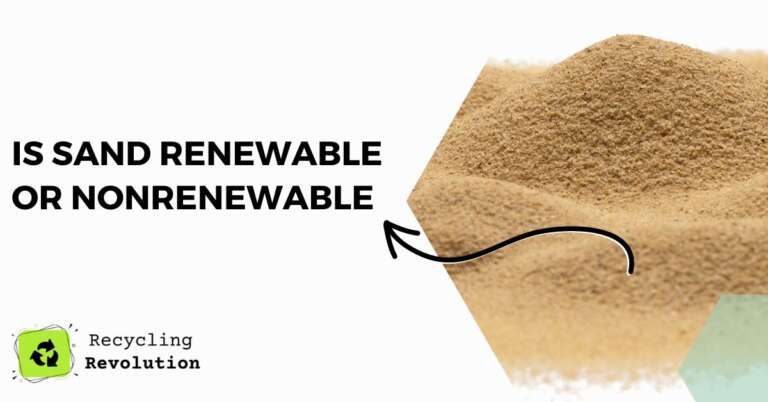Sand, the ubiquitous granular material found on beaches, riverbeds, and deserts, is often taken for granted. It’s easy to assume that such a common substance is infinite and inexhaustible.
TL;DR: Sand is a naturally occurring resource that plays a crucial role in various industries and ecosystems. While it might seem abundant, excessive and unsustainable extraction is causing serious environmental concerns. The renewability of sand depends on responsible management practices and understanding its intricate role in the environment.
The Origins of Sand: A Geological Journey
To comprehend the renewable or nonrenewable nature of sand, we must first understand its geological origins. Sand is primarily composed of small, loose particles of rock and mineral fragments, with its size falling between that of silt and gravel.
These grains have undergone years of weathering and erosion, breaking down larger rocks and minerals into the fine particles we recognize as sand today. This geological process takes place over vast periods, making sand, in a sense, nonrenewable on human timescales.
The Versatile Usages of Sand
Sand is a versatile material that finds application in an array of industries. From construction and manufacturing to agriculture and electronics, sand is an essential component.
Concrete, the backbone of modern construction, is made by mixing sand with cement and aggregate. The glass in our windows and smartphone screens relies on high-quality silica sand. Even in the realm of technology, silicon chips are manufactured using refined sand.
However, sand’s applications extend beyond the industrial sphere. Beaches and sand dunes serve as crucial habitats for various species, offering nesting grounds for sea turtles and other creatures. Coastal ecosystems rely on the natural movement of sand to maintain their delicate balance. Sand’s significance thus transcends its utilitarian value, making the sustainable management of this resource essential.
The Perils of Unregulated Extraction
While sand might be abundant in many parts of the world, the extraction of sand is not without consequences. Sand mining, both legal and illegal, has been on the rise to meet the growing demands of urbanization and construction. This unregulated extraction poses a grave threat to ecosystems and local communities.
Sand mining disrupts aquatic habitats, alters river courses, and contributes to erosion, which in turn affects water quality and agricultural land.
Excessive sand mining can lead to a phenomenon known as “sand scarcity.” This is particularly concerning given the vital role sand plays in replenishing beaches and maintaining coastal stability.
When sand is extracted faster than natural processes can replace it, the consequences can be dire, resulting in increased coastal erosion and vulnerability to storms.
Sustainable Sand Management: A Prerequisite for Renewability
To address the question of sand’s renewability, we must focus on responsible management practices. I recommend adopting a holistic approach that considers both the short-term demands and the long-term environmental impact. Sustainable sand mining practices involve regulating extraction rates, protecting sensitive ecosystems, and employing alternatives such as recycled materials in construction.
Note: Research studies have highlighted the importance of establishing clear regulations and monitoring mechanisms for sand mining activities. These studies emphasize the need to strike a balance between economic growth and environmental protection.
The Role of Science and Innovation
Scientific advancements and innovative technologies play a pivotal role in shaping the future of sand usage. Researchers are exploring alternatives to traditional sand sources, such as using crushed waste glass, bottom ash from thermal power plants, and even desert sand after suitable processing.
These alternatives not only address sustainability concerns but also reduce the pressure on natural sand resources.
Furthermore, advancements in materials science are leading to the development of stronger and more resilient construction materials that require less sand. Nanotechnology is enabling the creation of materials with enhanced properties, potentially revolutionizing the construction industry’s reliance on traditional resources.
Sand’s Global Impact: A Call to Action
The global demand for sand raises critical environmental and social concerns. It’s imperative to recognize that even though sand is abundant in some regions, its extraction can have far-reaching consequences beyond those areas.
Ecosystems, livelihoods, and coastal resilience are interconnected aspects affected by sand mining.
I recommend that governments, industries, and individuals collaborate to establish and implement sustainable sand management practices. Investing in research, technology, and public awareness campaigns can lead to a more balanced approach to sand extraction and utilization.
The Ecological Impact of Sand Extraction
Sand extraction isn’t just an economic issue; it has profound ecological implications. Rivers, oceans, and coastlines depend on the natural movement of sand for erosion control, habitat maintenance, and overall ecosystem health.
When sand is extracted from rivers and beaches, these delicate ecosystems suffer. The alteration of riverbeds can disrupt aquatic habitats and hinder the migration of fish. Coastal erosion, exacerbated by sand mining, can lead to the loss of valuable land, threatening communities and biodiversity.
The biodiversity supported by sandy habitats is often overlooked. Coastal dunes, for example, provide nesting grounds for various bird species, including endangered ones like the piping plover.
These dunes act as natural barriers against storm surges and play a crucial role in maintaining the integrity of coastal ecosystems. Unsustainable sand mining puts these habitats and their inhabitants at risk, emphasizing the need for a comprehensive approach to sand management.
Unravelling the Global Sand Trade
Sand might seem like a locally abundant resource, but the global demand for specific types of sand has led to a lucrative international sand trade.
Some regions, due to their unique geological characteristics, produce high-quality sand that is sought after in construction and manufacturing industries. This global demand has driven unsustainable extraction practices in some areas, leading to ecological damage and social conflicts.
In some cases, sand extraction has been linked to illegal activities and even organized crime. The scarcity of sand in certain areas has created a black market, further underscoring the need for transparent and accountable sand management practices.
Community Involvement and Advocacy
The impact of sand extraction isn’t limited to the environment; it affects communities as well. Many local communities depend on fisheries, tourism, and other activities tied to healthy coastal ecosystems. Unsustainable sand mining can disrupt these livelihoods and create social tensions. Moreover, marginalized communities are often disproportionately affected by the negative consequences of sand extraction.
I recommend that communities and advocacy groups engage in dialogue with local authorities, industries, and environmental organizations. By voicing concerns, raising awareness, and participating in decision-making processes, communities can play a pivotal role in ensuring that sand extraction is carried out responsibly and sustainably.
Regulations and Enforcement
Clear regulations and effective enforcement mechanisms are critical in achieving sustainable sand management. Governments need to implement stringent guidelines that control extraction rates, protect sensitive areas, and rehabilitate sites post-extraction. Monitoring and auditing mechanisms can help track extraction activities and ensure compliance.
A notable example is Singapore, a country that imports large amounts of sand for its land reclamation projects. In recent years, Singapore has invested in sustainable sand management practices, emphasizing responsible sourcing, reducing demand, and utilizing alternatives like recycled materials.
Educating Industry and Consumers
Sustainable sand management isn’t solely the responsibility of governments and environmental organizations. Industries that rely heavily on sand, such as construction and manufacturing, have a role to play in minimizing their impact. Adopting circular economy principles, embracing sustainable design, and exploring sand alternatives can contribute to a more responsible sand supply chain.
Educating consumers about the impact of their choices is equally vital. When people demand sustainable products and support environmentally conscious practices, industries are more likely to adopt greener approaches.
The Complexity of Sand’s Renewability
The renewability of sand isn’t a simple binary distinction; rather, it lies on a spectrum. While sand itself is formed through natural geological processes, its availability as a resource that benefits ecosystems, industries, and communities depends on human actions. The challenge is to strike a balance between fulfilling societal needs and safeguarding the environment.
Sustainable sand management is a multifaceted endeavor that requires collaboration across sectors and global cooperation. As individuals, industries, and governments recognize the interconnectedness of sand with various aspects of our world, they can collectively contribute to ensuring its long-term availability and positive impact.
Note: Research studies, such as those conducted by the United Nations Environmental Programme (UNEP), highlight the need for a comprehensive global assessment of sand resources, extraction rates, and environmental impacts. These studies underscore the urgency of addressing sand-related issues on an international scale.
In the pursuit of a more sustainable future, it’s imperative to move beyond the surface of this seemingly abundant resource and consider the intricate web of relationships that sand supports. The answer to whether sand is renewable or nonrenewable is intricately tied to our actions, innovations, and commitment to preserving the planet’s well-being.
Conclusion
In conclusion, the question of whether sand is renewable or nonrenewable isn’t straightforward. While sand itself is formed through geological processes that take place over vast time scales, its availability on human-relevant time frames depends on how we manage its extraction and utilization. Irresponsible sand mining and unchecked demand pose significant threats to ecosystems, habitats, and communities.
Embracing sustainable practices, supporting innovative research, and raising awareness about the intricate role of sand in our world are essential steps to ensure its continued availability. Striving for balance between economic growth and environmental stewardship is the key to ensuring that sand remains a resource we can rely on without jeopardizing the planet’s well-being.
FAQ
Is sand considered a renewable resource?
Sand is a naturally occurring resource formed over geological time scales, which makes it nonrenewable on human timescales. However, responsible management practices can ensure its availability for the future.
Why is sand mining a concern?
Sand mining can lead to habitat destruction, riverbed alteration, coastal erosion, and environmental degradation. Excessive extraction without proper regulation can have far-reaching negative impacts.
Can sand alternatives replace natural sand?
Researchers are exploring various alternatives to natural sand, such as crushed waste glass and processed desert sand. While these alternatives show promise, their widespread adoption requires further research and development.
What can individuals do to address sand-related issues?
Individuals can contribute by promoting awareness about responsible sand consumption, supporting sustainable building practices, and advocating for effective sand management regulations.
How can governments ensure sustainable sand management?
Governments can establish and enforce regulations on sand extraction, invest in research for alternatives, and collaborate with industries and communities to develop sustainable sand management strategies.
Remember, the granular truth about sand lies in its delicate balance between geological processes and human intervention. By understanding and addressing the complexities surrounding sand’s renewability, we can shape a more sustainable future for this invaluable resource.

